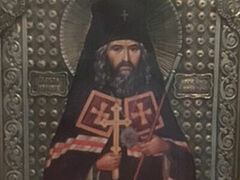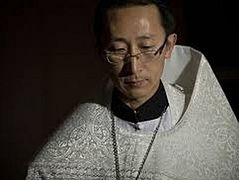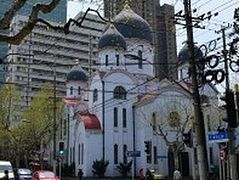 The jungles of Zimbabwe.
The jungles of Zimbabwe.
Archpriest Pavel Volmensky is one of the most well known Orthodox pastors in Western America; he is rector of the Holy Ascension Church in Sacramento, the capital of California. I am indebted to my dear friend and assistant Mikhail Arsentiev for my meeting and talk with him.
Archpriest Pavel Volmensky’s great-grandmother, grandfather and grandmother of were born in the imperial Russia, came to America from China, having made the difficult journey of refugees: Harbin, Shanghai, Hong Kong, England, Rhodesia, Tubabao and San Francisco. During our meeting Fr. Pavel recalled their lives, wanderings and amazing adventures.
In Shanghai
Shanghai was dubbed “the Paris of the East”, “the largest port in the Far East”, and “a city of skyscrapers”. The port of Shanghai with its foreign concessions and branches of world famous companies seemed to many to be the “promised land.” The world’s latest inventions instantly appeared there: electricity, the tram, the first car in China, and the modern sewage system.
How did Shanghai present itself to the Volmenskys? Trams rang their bells, horns of cars and buses roared, horse hooves clattered, and Chinamen (with swollen blue veins in their calves) trotted along in slippers, clutching the shafts of one-passenger carriages in their thin hands. Russians and Frenchmen in European suits walked to banks and offices, Chinese clerks in almost identical blue caftans and black satin hats hurried to offices and shops, and black-bearded mounted Sikh police officers (brought by British from India) pranced along the paved road.
There was no passport regime in that huge city. You could come and check into a hotel, calling yourself whatever you liked, even identifying yourself as the Count of Monte Cristo, and that didn’t bother anyone as long as you were paying for your room.
Russians could tackle any job there; they worked as doctors and teachers, journalists and taxi drivers, governesses, waiters, servants, sellers... Russians excelled as police officers—they were clearly preferred to Chinese and even Irish ones. The Russian volunteer corps regiment in Shanghai numbered about 900 men. The regiment had an excellent reputation: The wealthy Chinese didn’t trust their compatriots and preferred to hire Russians who were valued as brave warriors, reliable guards and bodyguards.
As musicians Russians were unrivalled as well. There were both individual musicians and whole orchestras playing jazz. One of those musicians was my grandfather—he played the trumpet in the officers’ clubs and thus provided for his family.
 Russian musicians in Shanghai, the 1930s
Russian musicians in Shanghai, the 1930s
Life in Shanghai
For the Volmenskys the local monsoon climate was perhaps even worse than that of Harbin: humid air from the ocean reached Shanghai, located nearly at sea level; typhoons raged almost every spring, tearing off roofs from fanzas (traditional Chinese houses), and showers could last for weeks. There were humid heat waves in July and August when the temperatures rose to +40-45°C (+104 to 113°F). There was no sharp frost in winter, but due to high humidity Shanghai residents felt the cold terribly.
Perhaps the best time of the year was autumn, when tropical showers stopped, humidity levels kept low, and finally dry, sunny weather set in.
The Japanese occupation of Shanghai
A few years later, the Japanese reached Shanghai. In July 1937, after a brutal artillery preparation and aerial bombardment, Japan, which had long had an eye on China’s raw materials, landed its troops in the vicinity of the city. The Chinese army was unable to withstand the Japanese, and Shanghai was invaded.
Having occupied the city, the Japanese at first did not touch the foreign concessions—they didn’t want to complicate their relations with the UK and France. All that was required of the white people was loyalty to Japan. However, in time the invaders began to treat the Europeans increasingly worse. During the occupation the Japanese built five internment camps in Shanghai: four for civilians and one for prisoners of war.
The famous Russian émigré writer Antonina Fyodorovna Ryazanovskaya (Nina Fyodorova; 1895–1983) recalled:
“The pressure from Japan intensified. When at the British concession a Japanese officer lashed an English policeman on duty with a whip across the face, everyone understood that it was a serious matter and that Japan was not just a bandit but a global power. To Europe that slap in an Englishman’s face meant more than thousands of square miles of devastated Chinese fields and half a million killed Chinese. And those who had the means and the opportunity rushed to their consulates to get visas to return to their homelands.”
 The Japanese Emperor Hirohito inspects the troops.
The Japanese Emperor Hirohito inspects the troops.
My family saw terrible things happening around
In those difficult years, the earnings of my grandfather, a trumpet player, were very modest—it was just a handful of (often wormy) rice per day for a family of three. My grandmother also made artificial flowers and sold them to supplement their earnings.
My father had bad teeth due to poor nutrition in childhood. My relatives saw scary things happening around. Once as my grandmother and her little son (my future father) were walking down a street, she saw the corpse of a hanged man dangling from a rope. His appearance was terrible, and my grandmother covered my father’s eyes with her hand so the boy couldn’t see that horrible sight and get frightened.
My grandmother was sick all her life, even when she was young. And as a boy my father would make breakfast for himself and for his mother and then go to school.
My grandfather avoided reminiscing about those times: he didn’t like to recall bad things. My grandmother told us a little...
 Mass executions of Chinese in Nanjing
Mass executions of Chinese in Nanjing
Hong Kong
In those years my grandfather tried to find a safer place for his family and took his wife and son to Hong Kong. My great-grandmother with my grandfather’s brother and sisters—Andrei, Nina and Evgenia—remained in Shanghai.
My grandfather was looking for a peaceful life for his loved ones. But, alas, there was no peace in the new place either. On December 8, 1941, the Japanese attacked Hong Kong. For about twenty days the British and Canadian units defended the colony, but the Japanese Empire got the better of them. Britain lost about 2,000 soldiers in the defense, and Japan lost about 3,000.
All the British and Canadian servicemen, along with citizens of the states hostile to Japan, ended up in concentration camps. The Volmenskys were Russian refugees—stateless persons (apatrides)—and the Japanese didn’t touch them. British sovereignty over Hong Kong was restored when Japan surrendered in August 1945.
England, Torquay
After the Japan’s surrender, my courageous and enterprising grandfather with his wife and son Vitaly (my future father) moved to England. Vitaly was eleven and he had already lived in Shanghai and Hong Kong. In England they took up residence in Torquay, a resort town on the south coast, in Devon. At long last the Volmenskys had a reprieve from the harsh climate of Harbin and the monsoon climate of Shanghai—Torquay has the warmest and mildest winters in the UK and excellent summer weather. All around them were green fields, steep hills, and beautiful coastlines with many bays.
My grandfather began to work as a car mechanic and fix cars—he could always find work to support his family. My grandmother continued to make artificial flowers, and even UK residents appreciated them.
Harbin in those years
Sometimes I ask myself: “Would it have been better if my grandparents had stayed in Harbin and then returned to the USSR?” Certainly not! In mid-August 1945, the Russian residents of Harbin welcomed the Soviet troops with joy. Everyone took to the streets, shouting joyfully, “Hurrah!”, joined even by the Chinese.
Soviet rule was established in Harbin for two months. The St. Nicholas Cathedral (where my grandparents were married) was used as the headquarters of the SMERSH (an acronym for “death to spies”) counterintelligence agency, and mass executions were carried out in the city every night. And then tens of thousands of innocent Russian people were killed or sent to Stalin’s labor camps.
Those who survived remembered for a long time the “great Soviet banquet” in honor of the victory over Japan. On September 2, 1945, the Soviet authorities sent invitations to the best people in Harbin: scientists, teachers, musicians, engineers... The happy guests put on their best suits and went to the last banquet in their lives. During the celebration a Soviet general proposed a toast “to the wonderful Russian people living in China who have provided invaluable assistance to the Soviet Army in securing the victory over Japan; to the flower of the male population of Harbin—to you heroes! Hurrah!”
And the residents of Harbin happily applauded the general. After the solemn feast, Soviet soldiers with machine guns seized them and sent some to the Soviet consulate, others to prison, and then escorted them to the station. They didn’t understand anything and didn’t have time to say goodbye to their relatives, who never found out the truth about their fate.
Those who miraculously survived recalled how they were transported into the depths of Russia: some to Siberia, others to the Urals. The cold cars were stuffed with bunks in two rows, and the prisoners had to sleep huddled against one another. They were rarely allowed to use the toilet, and there was dreadful stench all around. At the stops coal was thrown into a cast-iron moveable wood stove, and for some time they fainted from stuffiness, though soon they would be cold again and their teeth would chatter.
From time to time they were given frozen bread, and very rarely—some skilly, a semblance of soup. There was a catastrophic shortage of drinking water, and the prisoners licked the condensation from the car walls. They were also severely tormented by lice, so they scratched their skin to the point of bleeding. Gradually they began to die—from bloody diarrhea, cardiovascular insufficiency, croupous pneumonia, kidney failure...
The corpses were not taken out of the cars for a long time; they froze to the floor covered with ice, and the living prisoners stumbled over the dead ones. At some stations the corpses were carried out and buried somewhere hastily, and their relatives would never find their graves. After that, labor camps seemed like paradise to the surviving prisoners, but almost no one came out of those camps alive. So the fate of Harbinians for the most part was very tragic. And if my great-grandparents had not left for Shanghai, these lines would never have been written.
Rhodesia
My father studied in the UK between the ages of eleven and seventeen, and then at age seventeen he went to serve in Rhodesia, then a British colony in South Africa (present-day Zimbabwe). He was draft age in the UK, and my father had to choose between going to Rhodesia and serving in an engineering battalion, or going to war-torn Korea.[1]
My father didn’t want to take part in hostilities, so he chose Africa. My grandparents were very nervous—it was faraway and unknown Africa with dangerous diseases, such as malaria and yellow fever... But his choice turned out to be right—the regiments that had been sent to Korea fell into a trap, and not a single British soldier returned alive.
My father served in Rhodesia as an engineering drafter from 1951 till 1956 or 1957. That is, he came to Africa as a seventeen-year-old youth and left at twenty-three as a mature man. Apparently, he was interested in his work there. In my childhood he gladly showed us transparencies—photographs of his hikes, with elephants, giraffes and large hills (ants’ nests).
San Francisco and the Volmensky family reunion
My great-grandmother Ekaterina Markelovna Volmenskaya with my grandfather’s sisters, Nina and Evgenia, and their brother Andrei, went through trials and tribulations as well. As I said, when my grandfather took his wife and son to Hong Kong, they decided to stay in Shanghai. After the Japanese occupation a civil war broke out in China, and 1949 marked the offensive against Shanghai by communists led by Mao Zedong. Their arrival threatened the Russians with deportation to the USSR and Stalin’s camps or Chinese prisons—Chinese communists were very cruel to their ideological opponents.
And then Vladyka John of Shanghai and Gregory Bologov, the Chairman of the Russian Association of Emigrants of Shanghai, managed to come to an agreement with the International Refugee Organization (IRO) and evacuate the Russians from Shanghai to the tiny Philippine island of Tubabao. Everyone thought they would spend a couple of months there, but instead they had to live there for years.
The Russians left the island and moved to different countries (the ones that accepted them): Argentina, Brazil, Paraguay, Chile, the Dominican Republic, Surinam, Australia... Thanks to the intercession and fervent prayers of Vladyka John of Shanghai, a large group of Russian refugees was taken from Tubabao in three stages to San Francisco in 1951. As part of that group, my great-grandmother and my grandfather’s sisters, Nina and Evgenia, with their husbands and children, came here. My Grandfather’s elder brother, Andrei, first went to Australia, and only then to San Francisco—to his mother and sisters.
In 1953, my forty-two-year-old grandfather Viktor Alexeyevich and forty-year-old grandmother Evgenia Vasilievna Volmensky moved from Torquay in the UK to San Francisco, to their loved ones. In 1957, after serving in Rhodesia my father was reunited with his family. My grandparents were still relatively young (and my father was very young), but what they had seen and experienced would have been enough for ten lifetimes.
The life of my great-grandmother contained so many events and catastrophes of the twentieth century!
My great-grandmother Ekaterina Markelovna Volmenskaya lived for almost two more decades and fell asleep in the Lord in 1975. Amazingly, she was born in 1888, and her life contained so many events and catastrophes of the twentieth century!
My great-grandmother remembered life before the Russian Revolution, the Russo-Japanese War, Russian Harbin on Chinese soil, how her husband navigated the ship along the yellow Songhua River, how they lived in Shanghai, were nourished by the great saint of the twentieth century—St. John of Shanghai—and how they lived under his protection on the tropical Philippine island of Tubabao.
There was sweltering heat there all year round—about +45°C (+113°F). Frequent rains gave way to the scorching tropical sun, and at night damp coolness descended on the tent city, causing clothes to become moldy. In such a climate, skin diseases developed instantly: acne, abscesses, boils...
There were even more serious conditions: gastroenteritis, dysentery, tuberculosis and the tropical Dengue fever, transmitted by monkeys and bats (there were a lot of them on the island). But the Russians were protected by the prayers of St. John of Shanghai, and to local residents’ surprise, even destructive typhoons bypassed Tubabao.
 St. John of Shanghai on Tubabao, 1949
St. John of Shanghai on Tubabao, 1949
In 1959, my father married my mother, and in 1961 I was born in Monterey, California. May God bless you all!













